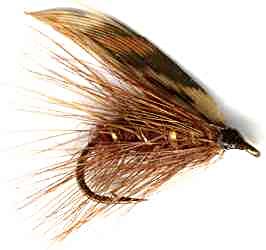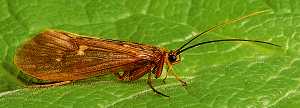Brown Murrough Sedge Caddis Wet Fly
I was lucky to be fishing the River Shannon at Castleconnell in Ireland last year, when the local great red caddis were hatching. They are known in Ireland as Murrough Sedge.

CADDIS WET FLY PATTERNS. Hook size 10 12 14 - $US each
The Morrough Caddis were scuttling over the surface but I notice most of the activity was just under the surface. I tied on a Brown Murrough wet fly in hook size 10 that I had put in my fly box to catch trout but instead it caught four Grilse Salmon all around the 5 lb range.
CADDIS FLIES
The common or slang term ‘sedge’ originates from the fact that adult Caddis flies can often be found clinging to sedge grass near the waters. Sedge/Caddis flies have four wings. The forward pair are normally a little longer than those at the rear. At rest their wings lie close along the body in an inverted V shape. Caddis flies do not have tails but many have long antenna. The Latin name for this group of flies is ‘Trichoptera’ (Greek for 'hairwing'). They pass through four stages in their development; egg, larva, pupa and adult. The eggs are laid by the adult female in large jelly mass, which often floats on the water surface and drift until they stick to some river side vegetation. Some species lay their eggs directly on vegetation. The eggs hatch into larva in about 10-12 days. The Larvae produce a sticky substance and attach what ever material in on the river bed to their body. This offers protection and camouflage. The pupa stage lasts for several days. The fully formed pupa has middle body legs that it uses to swim to the surface to hatch. Some species choose the shore or vegetation to emerge rather than open water where they are easy prey for the trout. Adult caddis flies vary in size. Their bodies are rather drab in color from gray, brown to green. The wings are mottled, patterned or pale and vary in colour from black, brown to gray. If the fish are not taking fly patterns of natural colors try a brightly colored attractor pattern of the correct shape. Most hatch early or late evening. Some hatch in the afternoon and some at night. The fish have two chances of catching these flies; when they emerge and when they return to lay eggs. Some species have a problem drying their wings and remain on the surface for a considerable time, causing a disturbance. Others that move to shore to hatch fully also cause a disturbance

I like to fish wet flies in the rain. If you are one of those fine weather fishermen you are missing a lot of sport. On sunny days the fish swim near the bottom of the river, lake or stream for a number of reasons. They do not have eye lids and the sun can damage the eyes. More importantly the warmer the water becomes the less oxygen it can hold. Fish find warm water uncomfortable. The colder the water temperature the more oxygen the water can hold. When it rains the disturbance caused on the water surface increases the oxygen content of the upper levels of water because when the water droplets force their way through the water surface air gets trapped behind it. If it is raining it normally means the sky is overcast and therefore the temperature of the water decreases. This cooling effect is also helped by the rain drops which are normally cold and help cool the upper water levels of the lake or river to a more pleasant fish friendly environment.
They feel safer as choppy water makes them invisible to birds of prey. Heavy rain will knock airborne and surface insects down and into the water. More fish than normal rise from their bottom feeding location to the surface to feed from this bounty of drowned insects. Heavy rain also washes terrestrial insects like ants, beetles and Hoppers into the water from the land, overhanging trees and shrubs. Summer storms are primetime for subsurface fishing with a wet fly. Further advantages of fishing in heavy rain is that perfect fly presentation is less important. A fish who is stimulated by the abundance of drowned insect food, whilst on the look out for predators, will not have time to consider such things.
When the all the fair-weather fishermen are hiding under trees, in fishing huts or in their cars to keep dry, you will reap the rewards of some exciting fishing if you stay out in the rain. Just cast out your fly and let the rain drown it, just like what is happening to the real insects. Do not add any floatant. It is best to cast frequently as you will cover more water and I have found that the fly is normally taken just after it has broken the water surface. Fishing in heavy rain is an ideal time to try out new patterns . Trout have learned to expect a variety of different foods, not normally available to them,


Fly Fishing books

